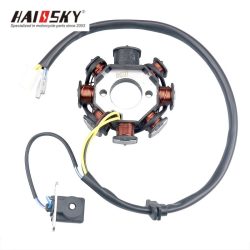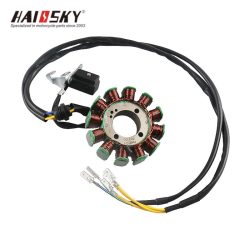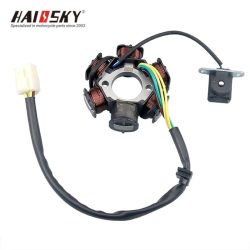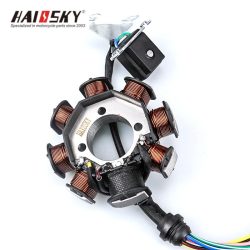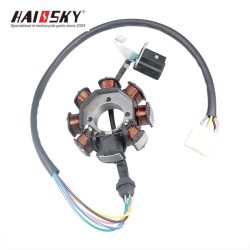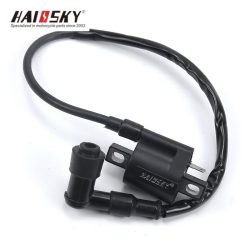OEM Motorcycle Parts
Category: Motorcycle Ignition Coils - High-Output Systems
The Ultimate Guide to Motorcycle Ignition Coils: Everything You Need to Know
The motorcycle ignition coil is a critical component of the ignition system, responsible for transforming the battery’s low voltage into the high-voltage spark needed to ignite the air-fuel mixture in the engine. For B2B wholesalers and motorcycle enthusiasts, understanding the purpose, types, and maintenance of ignition coils is essential. In this guide, we’ll dive deep into everything you need to know about motorcycle ignition coils, while optimizing for the keyword “motorcycle ignition coil” to help you make informed decisions for your business or customers.
What is a Motorcycle Ignition Coil?
The motorcycle ignition coil is an electromagnetic device that converts the battery’s 12-volt current into a high-voltage spark (typically between 20,000 to 45,000 volts) required to ignite the air-fuel mixture in the engine’s combustion chamber. It consists of two windings: the primary winding, which receives low-voltage current from the battery, and the secondary winding, which generates the high-voltage spark. Without a functioning ignition coil, your motorcycle’s engine won’t start or run efficiently.
Types of Motorcycle Ignition Coils
Ignition coils come in various types, each designed to meet specific performance and operational needs. Here’s a breakdown of the most common types:
1. Standard Ignition Coil
The standard ignition coil, also known as the conventional coil, is commonly found in older motorcycles and low-voltage ignition systems. It uses low resistance in its primary winding to generate a strong magnetic field, which collapses to produce a high-voltage spark. While reliable, it requires regular maintenance of ignition points, which can be a drawback.
2. Dual-Output Ignition Coil
Also called a twin-output or wasted spark coil, this type of ignition coil has two secondary terminals that supply high voltage to two spark plugs simultaneously. One plug fires during the power stroke, while the other fires during the exhaust stroke. This design improves ignition reliability, reduces emissions, and enhances engine performance. It’s commonly used in inline and V-twin engine configurations.
3. Single-Output Ignition Coil
The single-output ignition coil is used in motorcycles with advanced ignition systems, such as those with electronic control units (ECUs). It supplies high voltage to a single spark plug, allowing for precise control of ignition timing and energy delivery. This type of coil is ideal for high-performance motorcycles and racing applications.
4. CDI Ignition Coil
The Capacitor Discharge Ignition (CDI) coil is designed for motorcycles with CDI ignition systems. It stores electrical energy in a capacitor and discharges it as a high-energy pulse to the spark plug. CDI coils generate a more powerful and precise spark, making them suitable for high-performance and racing motorcycles.
5. High-Performance Ignition Coil
High-performance ignition coils are designed to produce a stronger and more stable spark than standard coils. They often feature higher primary and secondary resistance values, as well as advanced materials like copper or silver wire, to improve spark quality and combustion efficiency. These coils are ideal for racing and high-performance street bikes.
6. Digital Ignition Coil
Digital ignition coils are used in motorcycles with digital ignition systems, such as those with ECUs or digital ignition control modules. They allow for precise control of ignition timing and energy delivery, optimizing performance for different operating conditions. These coils are commonly found in high-performance and racing motorcycles.
How Do I Know if My Motorcycle Ignition Coil is Bad?
A faulty ignition coil can cause a range of issues. Here are some common signs to watch for:
Difficulty Starting: The engine may struggle to start or fail to start altogether.
Engine Misfires: The engine may misfire or run unevenly due to inconsistent spark delivery.
Loss of Power: The motorcycle may experience a noticeable loss of power and performance.
Poor Fuel Efficiency: A weak or inconsistent spark can lead to incomplete combustion, reducing fuel efficiency.
Check Engine Light: Some motorcycles have a check engine light that may illuminate if there’s an issue with the ignition system.
To confirm, you can perform a spark plug inspection or use a multimeter to test the coil’s resistance and voltage output.
What Are the Symptoms of a Failing Ignition Coil?
The symptoms of a failing ignition coil are similar to those of a bad coil and include:
Weak or No Spark: If the spark plug fails to produce a spark, the ignition coil may be defective.
Intermittent Spark: A weak or inconsistent spark can indicate a failing ignition coil.
Engine Misfires: Misfires or rough idling can be caused by incorrect spark timing.
Backfiring: A failing coil can cause the engine to backfire due to unburned fuel in the exhaust system.
Check Engine Light: Some motorcycles have a check engine light that may illuminate if there’s an issue with the ignition system.
How Often Should You Change Ignition Coils on a Motorcycle?
The lifespan of an ignition coil depends on factors like usage, maintenance, and environmental conditions. On average, an ignition coil can last anywhere from 30,000 to 50,000 miles. However, exposure to moisture, heat, or electrical issues can shorten its lifespan. Regular inspection and maintenance can help extend its longevity.
What Causes a Motorcycle Ignition Coil to Fail?
Several factors can cause an ignition coil to fail, including:
Overheating: Excessive heat from the engine can damage the coil’s internal components.
Moisture: Exposure to water or humidity can cause corrosion and electrical shorts.
Vibration: Constant vibration from the engine can loosen connections or damage the coil.
Electrical Issues: Problems like voltage spikes or short circuits can damage the coil.
Age: Over time, the coil’s internal components can wear out, reducing its effectiveness.
How Do I Know if My Ignition Coil is Working?
To test if your ignition coil is working, follow these steps:
Use a Multimeter: Set the multimeter to the ohms setting and measure the resistance of the primary and secondary windings. Compare the readings to the manufacturer’s specifications.
Check for Spark: Remove the spark plug and connect it to the ignition coil. Crank the engine and check for a strong, consistent spark.
Inspect for Damage: Look for visible signs of damage, such as cracks, burns, or corrosion.
Maintenance Tips for Motorcycle Ignition Coils
To ensure your ignition coil lasts as long as possible, follow these maintenance tips:
Regular Inspection: Check the ignition coil for signs of wear, corrosion, or damage.
Clean Electrical Connections: Keep the coil’s terminals clean and free from corrosion.
Avoid Overheating: Ensure the coil is properly mounted and away from heat sources.
Check Wiring: Inspect the wiring for loose or damaged connections.
Follow Manufacturer Guidelines: Adhere to the manufacturer’s maintenance schedule for your specific motorcycle model.
How to Choose the Right Motorcycle Ignition Coil
When selecting an ignition coil for your inventory or customers, consider the following factors:
Compatibility: Ensure the coil matches the motorcycle’s make, model, and engine specifications.
Voltage Output: Choose a coil with the appropriate voltage output for the ignition system.
Performance Needs: For high-performance motorcycles, opt for a coil with advanced features like higher resistance or digital control.
Quality and Brand: Stick to reputable brands known for producing reliable and durable ignition coils.
Budget: Ignition coils come in various price ranges. Compare options within your budget to find the best value.
How to DIY and Replace a Motorcycle Ignition Coil
Replacing an ignition coil is a straightforward process. Here’s a step-by-step guide:
Tools Needed:
Screwdriver set
Socket wrench
Multimeter (optional)
Steps:
Locate the Ignition Coil: The ignition coil is typically located near the engine or under the fuel tank.
Disconnect the Battery: Start by disconnecting the negative terminal of the battery to prevent electrical shorts.
Remove the Old Coil: Disconnect the wiring harness and unscrew the mounting bolts to remove the old coil.
Install the New Coil: Connect the wiring harness to the new coil and secure it in place with mounting bolts.
Reconnect the Battery: Reconnect the battery and test the motorcycle to ensure the new coil is functioning properly.
FAQs About Motorcycle Ignition Coils
Q: Can a faulty ignition coil be repaired?
A: Ignition coils cannot be repaired. If there’s an issue, the coil must be replaced with a compatible one.
Q: Does the ignition coil require maintenance?
A: While ignition coils don’t require special maintenance, keeping electrical connections clean and secure can extend their lifespan.
Q: What’s the role of the ignition coil?
A: The ignition coil converts the battery’s low voltage into a high-voltage spark to ignite the air-fuel mixture in the engine.
Final Thoughts
The motorcycle ignition coil is a vital component that ensures your bike’s engine runs smoothly and efficiently. By understanding its purpose, types, and maintenance requirements, you can keep your customers’ motorcycles performing at their best. At Haissky.com, we offer a wide range of high-quality ignition coils to meet the needs of B2B wholesalers and riders alike. Explore our catalog today and keep the engines roaring!


